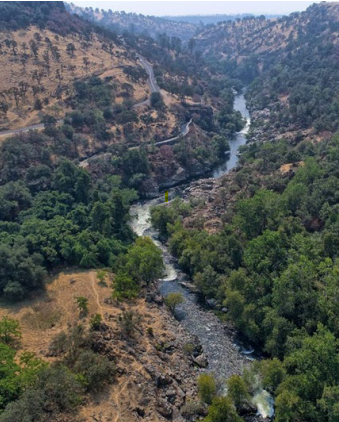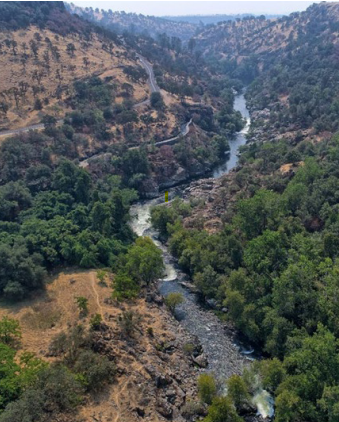The Bureau of Reclamation has completed a spawning gravel placement project on the Stanislaus River below Goodwin Dam that diverts water to the South San Joaquin Irrigation District.
The project’s purpose is to improve Chinook salmon, steelhead, and rainbow trout spawning and rearing habitat
“Reclamation is pleased to announce this habitat improvement project’s addition of 7,200 tons of gravel in the Stanislaus River,” said Bay-Delta Office Manager David Mooney. “This important work of restoring riverine habitats compliments New Melones Dam operation for supporting Central Valley Project species. We look forward to continuing gravel placement in the coming years.”
Naturally-spawned salmonid stocks have declined due in part to spawning and rearing habitat loss through reduced gravel recruitment. This reduction is caused by river-channel blockage by New Melones Dam and downstream-flow pattern alterations for flood control and water supply. A total of $500,856 in water-and-related resources funds ensured implementation for 2021.
Natural riverine habitats are created and maintained by the interaction between flowing water and sediment supply, and from the secondary influence of habitat components such as large woody debris. These habitats’ structure, complexity, and connectivity, combined with other factors, such as land use and species introduction, regulate species abundance and distribution.
These processes have been altered in the Stanislaus River by gravel and gold mining; removal of large woody debris; agricultural and urban development; and land, water, hydroelectric, and flood control project development.
The Stanislaus River has the most degraded channels of the San Joaquin tributaries. Goodwin Canyon is currently the furthest upstream area that Chinook salmon and steelhead reach on the Stanislaus River.
Since the installation of the Goodwin, Tulloch, and New Melones dams, the habitat has been degraded. The reduction of peak flows and sediment trapping in the reservoir decreases river dynamics, isolates the river floodplains, and removes the side channels. This causes channels to be overrun by riparian vegetation. Combined with in-river aggregate mining and the conversion of floodplain into farm land, the area of suitable salmonid spawning and rearing habitats has been reduced.
Reclamation added spawning gravel to the existing restoration site below Goodwin Dam, northeast of Knights Ferry. As much as 15,000 tons of gravel (10,000 cubic yards) was distributed. Gravel was placed at depths ranging from one-to-seven-feet deep. As gravel is distributed downstream by flows, more gravel has been added. Gravel has been placed at intervals of one-to-afew years apart, as the need is determined by ongoing monitoring of gravel conditions and fish use of the gravel. New gravel has been added to replenish the spawning gravel that naturally washes downstream. Gravels added to the river can make up for the deficit caused by the dams and maintain a mobile bed suitable for salmon spawning.
Through the years, the Stanislaus River has experienced incision as the water erodes the riverbed; the system has been deprived of upstream sediment inputs with dam installations. As this incision continues, the riverbanks can become higher and eventually become unstable and collapse, possibly impacting infrastructure and cultural resources within the river’s riparian area. When the gravel is added to the river, it can reduce the rates of bed incision, as well as help to stabilize the banks.
This project increases and improves the quality of spawning habitat with the addition of gravel. Increasing fish populations through improved habitat boosts hunting opportunities for foragers such as bald and golden eagles.
Learn more about this project by contacting Reclamation Fish Biologist Elissa Buttermore at 916-201-3009 or ebuttermore@usbr.gov; fact sheet available here: https://www.usbr.gov/mp/mpr-news/factsheets.html





